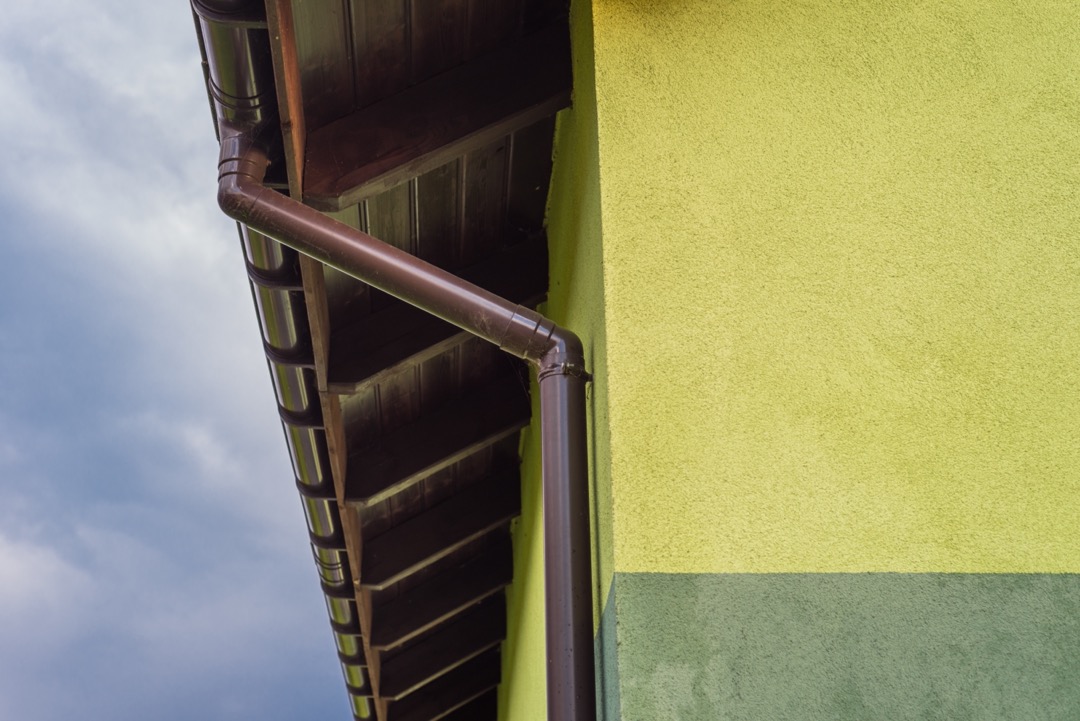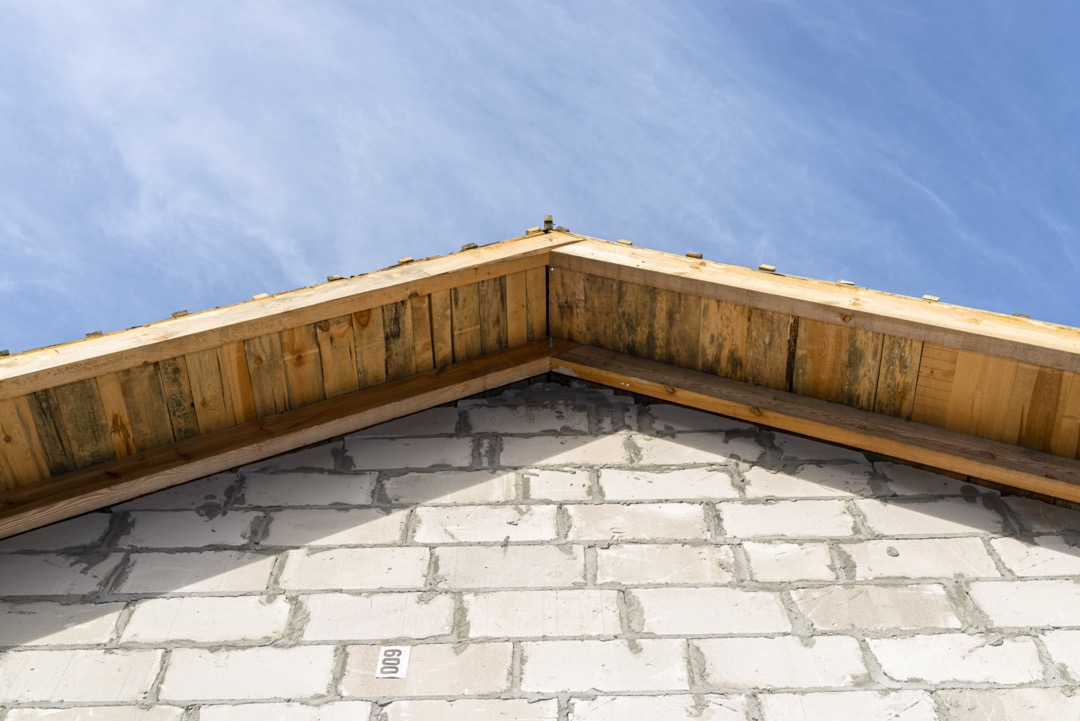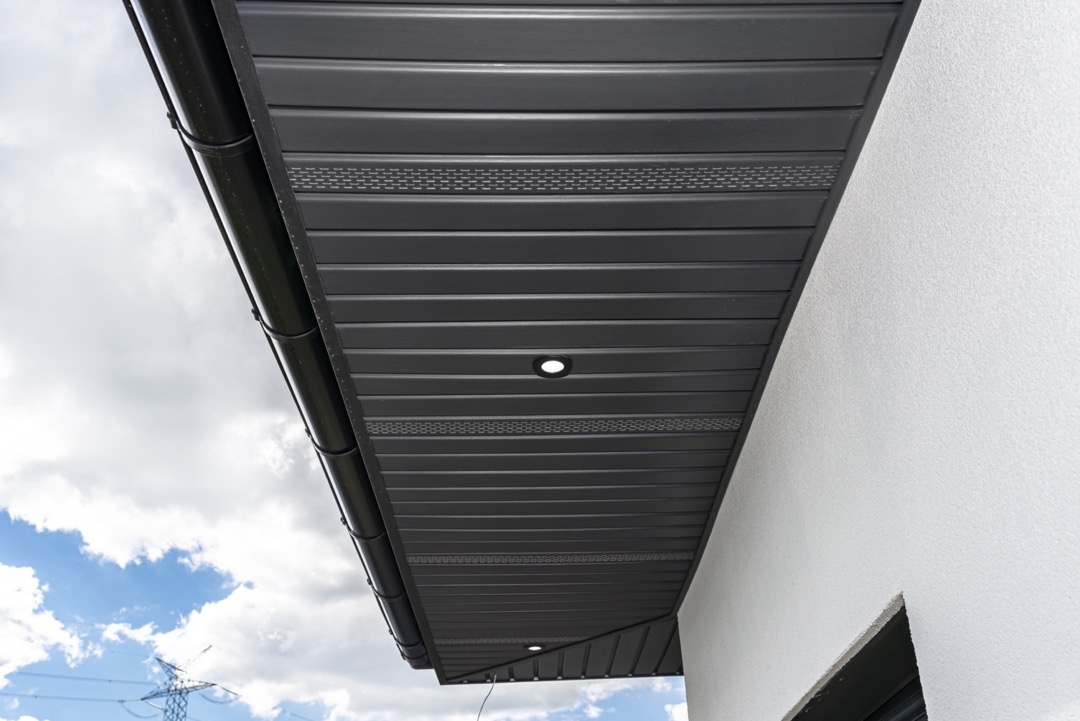
Home > Blog posts > Roof soffits, why are they so important?
Roof soffits, why are they so important?
Soffits are an important part of a sloped roof. But what are they exactly and why are they so important? Clinique de la toiture FCA explains the uses and advantages of soffits, and tells you how to install them properly.
What are soffits on a roof and what are they for?
Soffits on a roof are a type of layer that covers the inferior part of the roof edge: the cornice. Soffits used to be mostly made from aluminum, but today, PVC or vinyl soffits are the most common.
Generally perforated, soffits are fastened to the wooden structure of your cornices or eaves. The perforations allow for air to flow in the underside of the roof. This means that its main function is ventilation.
Soffits are only used on sloped roofs; flat roofs have another type of ventilation system, which is a little more complex. Ventilated soffits, as you have probably gathered, allow for airflow in the attic.
Soffits contribute to reducing excessing heat and prevents humidity from forming. By keeping humidity levels low, it also serves to prevent further damages to your structure, like those caused by mold, for example.
Soffits also play a protective role, not only against humidity, but also from severe weather conditions. It prevents wind and rain from entering the underside of the roof, which could cause material deterioration.
Animals and insects can also enter your house, if your roof is not protected by soffits. As you can see, it truly is an essential element for sloped roofs!
Soffits also obviously add to your roof’s overall look. On the one hand, if the corniche didn’t have a soffit affixed to it, that part of your roof structure would remain visible and make it look as though it is unfinished. On the other hand, soffits offer several esthetic options, allowing you to embellish your house even more.
There are several types of soffits on the market that are made from painted aluminum or PVC, or vinyl in several different colors. Rather than opting for regular white soffits, you could prefer black ones, or soffits made from PVC or vinyl that mimic natural wood.
Finally, soffits are completed by another essential part of your roof: the fascia. This part of the roof is vertical and links the soffit to the roof edge. It is also useful: it retains water, preventing it from penetrating into the wooden structure, for example.

How are soffits installed?
Installing a soffit on a roof is one of the most important steps when building a roof or renovating it. Since it plays an essential role in preserving the integrity of your structure and given how visible it is, it is important to install it properly!
To ensure durability, it must be correctly adapted to the roof’s frame. It is, however, possible to install soffits yourself, without having to call upon a team of professionals. If you wish to give it a go, here is how you should proceed.
You will first want to make sure to have all of the necessary tools and materials on hand:
- A stapler
- A square
- Scissors
- A pencil
- A circular saw
- Soffits and fascia (obviously!)
You must first install the soffit, and then the fascia. Before you begin installing the soffit, start by placing the trims. Staple them every 16- inches along the cornice edge.
Then comes the time to cut the soffits: you must cut one inch from each edge. To do this, you can leave it in the box to make sure that everything is cut evenly. Once you are finished cutting, make sure everything is straight by aligning the pieces and double checking with the square.
While the pieces are still in the box, determine the length you need with a pencil. Then, cut along the line with the circular saw.
After this is completed, you can begin installing the soffits. For better results, you’ll want to begin at the front –more precisely, at the corner where the parking is located- and finish at the back. Fold the soffit delicately and install it in the J trims, while also ensuring it is straight.
At the extremities of the cornice or eaves, cut the protruding parts of the soffit at a 45 degree angle. Voilà! Now comes the time for the fascia. To install the fascia, you must first measure the surface to be covered.
You can then start by cutting a 6- inch strip that you will use as a ruler. Take into account two inches for the folded part of the interior of the fascia.
You will then cut the fascia using the square and scissors: you will want to cut 10- and 4- inch strips, and notch the edges.
Fold the aluminum: fold the strip down at one inch, and a second time an inch further, at a 90 degree angle.
You are finally ready to install the fascia, moving from the front of the house to the back. Overlap the pieces over one and a half inches, and nail in the fascia every 5 to 7 folds of the soffit, to make sure it is firmly in place.
When you fold the corners, you’ll have to options: you can trace a line with a knife and press from the back, or simply use a pair of pliers.

The pros and cons of roof soffits
Soffits obviously bring several advantages thanks to the role they play. For example, they protect you from:
- Severe weather
- Water infiltration
- Mold
- Small animals
- Humidity
Moreover, the good ventilation they provide you will allow you to save money on heating and air conditioning! The different materials used also come with their own list of pros and cons. Some will even give you optimal fire and UV ray resistance, like steel for example.
A solid and properly installed soffit doesn’t have any cons; however, if it was not properly installed, it will now longer be offering adequate protection. This means that your home could be at risk of damages caused by humidity and severe weather conditions.
If it does not undergo proper maintenance, the soffit can also wear prematurely. Moreover, you have to make sure it is not blocked, thus ensuring proper ventilation.
You must also pay close attention to the joints between the soffits and the roof, given how they are more at risk of water infiltration. Caulking might be necessary.
In short, you will want to make sure that you are choosing resistant and durable soffits, and that they are installed properly.

How much do soffits cost?
The cost of soffits vary mostly according to the materials used. Soffits made from natural wood will obviously be more expensive than aluminum ones. In average, you can expect the cost to be around $ 10 per linear foot.
You can also find a wide variety of soffits, in various sizes, at your local hardware store.
If you want to ensure proper installation done by a team of professionals, you should expect anywhere between $ 8.50 and $ 14.50 per linear foot (according to an inspection service document done by Amerispec). This is an investment that can be well worth your while if you are unsure of your abilities!
Rules and regulations
Just like for any construction or renovations, it is important to take into account local rules and regulations. When it comes to soffits, the main rule that must be respected has to do with fire prevention.
In fact, some parts of the soffit must include specific protection. This is the case when it is installed less than 2.5 m over a window or a door, or less than 1.2 m on either side.
However, protection is not necessary if all of the rooms in your building or home that have windows are protected by automatic fire sprinklers. In any case, do not forget that wearing a harness is mandatory when working at a height of over 6 meters.
Now you know almost all there is to know about soffits and fascia for your roof, and understand that they work hand in hand. So, are you ready to begin your next roof renovations?
At Clinique de la toiture FCA, we specialize in flat roofs that do not require soffits. We can, however, help you with any construction, renovation or maintenance for the ventilation system on your flat roof. Do not hesitate to contact us with any question about your roof!
Testimonials and reviews from our customers
Trustindex vérifie que la source originale de l'avis est Google. Nous sommes très satisfaits des travaux qui ont été exécutés par l'équipe de la Clinique de toiture FCA. Nous avons eu des suivis rapprochés et la date des travaux fût respectée. Merci à toute l'équipe.Trustindex vérifie que la source originale de l'avis est Google. Nice job - professional team Happy to work with them Highly recommendedTrustindex vérifie que la source originale de l'avis est Google. Nous avons eu un excellent service, de l’inspection à l’exécution des travaux. Nous avons eu des photos avant et après les travaux. Je recommande cette entreprise!Trustindex vérifie que la source originale de l'avis est Google. Très satisfaite de l'efficacité de la compagnie, j'ai reçu toutes les réponses à mes questions. Merci à toute l'équipe.Trustindex vérifie que la source originale de l'avis est Google. Travail de professionnels. Entreprise à recommander.Trustindex vérifie que la source originale de l'avis est Google. L'équipe de Clinique de la Toiture FCA a fait un travail exceptionnel sur ma toiture. Le chantier a été nettoyé rapidement et efficacement, et le résultat final est impeccable. Je suis très satisfaite de la qualité du travail et du professionnalisme de l'équipe. Je recommande vivement cette entreprise à tous ceux qui ont besoin de travaux de toiture.Trustindex vérifie que la source originale de l'avis est Google. Excellent service: professionnel, courtois et efficace. Bon rapport prix et qualité du produite. Aucune hésitation à recommandé la Clinique de la Toiture.Trustindex vérifie que la source originale de l'avis est Google. La réfection de la toiture de l'immeuble a été faite en 2019 et nous sommes très satisfait d'avoir choisi la Clinique de la Toiture FCA. Des produits de haute qualité et un service après vente hors pair. On a eu une urgence dernièrement d'une fissure de la membrane à cause d'une terrasse en bois mal posée. J'ai appelé en urgence la Clinique de la Toiture FCA pour éviter des dégâts d'eau importants. L'estimateur Yohan Fournier, courtois et respectueux, a su contenir mon impatience et a fait une réparation temporaire en colmatant cette fissure. Quelques jours plus tard, l'équipe de Yohan est venue tout réparer à notre satisfaction. Leur approche au service du client est exemplaire. Je recommande leurs services et savoir-faire sans hésiter.Trustindex vérifie que la source originale de l'avis est Google. Nous sommes entièrement satisfaits de vos services, de la première rencontre avec votre estimateur qui nous a mis en confiance, à la réalisation des travaux qui a répondu à toutes nos attentes. Merci pour une toiture bien faite et performante. On sent déjà un meilleur confort dans les appartements situés au 2e étage. Nous vous recommandons à tous.
Need help?
Leave us your email address and we will contact you as soon as possible to assess your needs!
Put an end to your water infiltration your clogged drains your roof problems
Leave us your email address and we will contact you as soon as possible to assess your needs!
